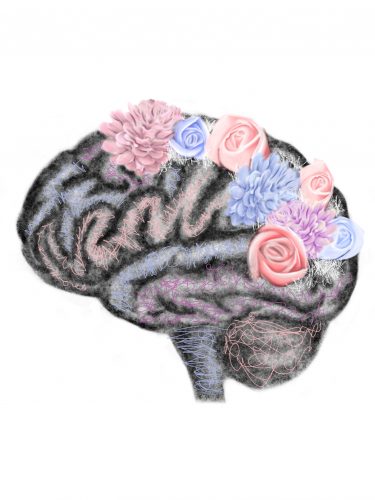Art by Anmei Little.
For someone who has spent her career studying neuroaesthetics—how brain sciences interface with the arts—Susan Magsamen has a surprising secret: she’s not a very good artist herself. “Like, not good at all,” she laughs. “Not a good writer, not a good drawer, not a good dancer, can’t sing at all. I will literally turn on Siri and sing as loud as I can, and I just hear my husband close the door upstairs.” Magsamen does not do it for the praise—she simply does it for herself and the pleasure she derives from it. And she’s devoted her life’s work to helping others realize how art can impact human potential.
Magsamen’s interest in the field started early. At age nine, she saw her twin sister immobilized and confined at home for a year and a half after a serious accident resulted in a compound fracture in her leg. An art class that her sister was able to take from home helped her come to terms with her feelings, get over the trauma of the accident, and ultimately save her life, Magsamen believes.
Now, as the founder and Executive Director of the International Arts + Mind Lab (IAM Lab), part of the Brain Science Institute at Johns Hopkins University School of Medicine, Magsamen and her team are focused on scientifically validating how art affects our minds, bodies, and behavior, as well as how that knowledge can be used in interventions at the personal, family, and community level. Her team is conducting a number of research projects that explore not only how the arts can improve health and well-being, but also consider the importance of personal preference when using art and aesthetic experiences as an intervention. For example, in collaboration with the Kennedy Krieger Institute, IAM Lab is building a multisensory care room to aid children waking up from coma, customized with a child’s favorite colors, scents, sounds and textures.
Although there is a growing body of research on neuroaesthetics, efforts in this emerging field have largely operated in isolation. One of Magsamen’s major goals is to “really coalesce all of the different disciplines and practitioners and researchers around the world who are already doing this work.” To do this, Magsamen’s team has created a scientific method to study the arts called Impact Thinking, a framework that can be consistently applied across the field to standardize research practices and scale the most promising, evidence-based interventions rapidly.
Magsamen is not only a passionate problem-solver and researcher, but also an established entrepreneur and children’s book author. Despite how different these fields may seem, Magsamen has “never felt uncomfortable shifting between [these spaces].”
“The through lines to all of my work have really been three things,” she said. “One is this idea around self-expression and finding, sharing, and celebrating voice.” The other is “collaborations and working with really amazing people.” The third is trying to understand why something is happening, a curiosity that drives her investigations into the underlying science of the arts.
Not all collaborations have been ideal, though. “Where I think there have been barriers has been coming up against traditional types of belief systems about what something should look like as opposed to what something could be. In the venture [capital] world, I came head up against primarily male–I’ll say differently, older, white male gatekeepers who were really just sexist,” she said. “I think that’s changing, but it’s really true, and I think to not name it is wrong.” Her advice: persevere through and hold your ground.
To all women in STEAM, Magsamen also emphasizes the importance of taking care of your mind and your body, as well as truly listening to yourself. “I do my best work when I sleep,” she laughed. She chooses not to make important decisions or answer questions late at night. “I needed to process and know what I thought before I was responding to what people wanted me to respond to.” In a society where art programs and experiences are often underfunded or viewed as frivolous, Magsamen’s work may teach us how important it is to incorporate art in our lives. “The arts and aesthetic experiences make us healthier and more human and connect us to ourselves,” she said. “We have become such a transactional culture, and sometimes we’re not as transformational and as fully alive as we can and should be.” Art doesn’t have to be produced by a prodigy to have value–it can do its greatest good when enjoyed by everyone, regardless of skill level.

